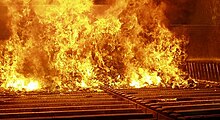Combustion technology

The Burner is a technical discipline that is concerned with the chemical process of combustion ( fire ) to make for the purposes of people available.
Content and tasks
Fire serves as an energy source for various processes in the household and everyday life ( heating , cooking food, lighting , ...), in industry and commerce ( process heat ) and in power generation . Such a fire for the benefit of humans is also called useful fire or purpose fire to distinguish it from destructive fires ( harmful fire) . The technical facility in which the useful fire burns is called a furnace or fireplace , ranging from relatively simple small-scale furnaces in the household sector to complex large- scale combustion systems in industry and power plants.
In combustion technology, the necessary technical devices and system components for the construction and operation of combustion systems are developed and optimized. The aim of combustion technology is the most efficient possible combustion with the highest possible energy utilization and operational reliability while minimizing the formation of air pollutants . The combustion technology is based on the fundamentals of combustion theory and is closely interlinked with the neighboring disciplines of energy process technology , in particular heat technology , heating technology and steam boiler construction , fuel technology and exhaust gas cleaning technology .
Vocational training
In the commercial sector burner technology is part of the training for various occupations such as the firing and chimney builder , the heating engineer , the chimney sweeps , the furnace manufacturers , the boiler operator (historically: heater ) or the Kraftwerker .
In university education, combustion technology is usually a specialization within the engineering courses of energy technology , process technology or mechanical engineering or within chemical technology .
BERUFENET and KURSNET from the Federal Employment Agency offer further information on study and training opportunities in the field of combustion technology .
history
Orders from Count Palatine Karl IV. From 1772 also served to prevent a fire in connection with domestic fireplaces. According to the simultaneous building regulations, no more wooden chimneys were allowed to be erected, no more wooden hoses were allowed to be installed, which had to lead the smoke from the fireplace to the fireplace , just as it was forbidden to lead stovepipes out of the window.
literature
- Werner Boie : From fuel to flue gas: Feuerungstechn. Calculating with fuel parameters, etc. its simplification by means d. Statistics . Teubner, Leipzig 1957.
- Fritz Brandt : Fuels and Combustion Calculation , Vulkan-Verlag, 1999
- Buderus : Handbook for heating technology , Beuth Verlag, Berlin-Vienna-Zurich, 1994
- Jacek Zelkowski: Coal combustion - fuel, physics and theory, technology , Vol. 8 of the specialist book series power plant technology , VGB-B 008, 1st edition (1986), VGB-Kraftwerkstechnik GmbH, Essen
- Klaus Görner: Technical Combustion Systems - Basics, Modeling, Simulation . Springer Verlag, Berlin [u. a.] (1991), ISBN 3-540-53947-6
Individual evidence
- ↑ R. Kneer: Lecture script for combustion technology , Chair for Heat and Mass Transfer, Rheinisch-Westfälische Technische Hochschule Aachen, online at www.wsa.rwth-aachen.de ( Memento from July 26, 2007 in the Internet Archive ) (PDF; 4.2 MB)
- ↑ http://www.berufenet.arbeitsagentur.de/
- ↑ http://www.kursnet.arbeitsagentur.de
- ^ Franz-Josef Sehr : The fire extinguishing system in Obertiefenbach from earlier times . In: Yearbook for the Limburg-Weilburg district 1994 . The district committee of the Limburg-Weilburg district, Limburg-Weilburg 1993, p. 151-153 .